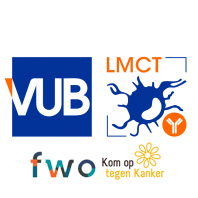
Development of LAG-3 nanobodies as potent cancer imaging tracers
Next generation targets & therapeutics
Information
Immune checkpoint blockade revolutionized anti-cancer therapy but unfortunately not all patients can benefit from it. The development of innovative and efficacious diagnostic methods that can guide treatment decisions is warranted. Nanobodies are small antigen-binding moieties that efficiently penetrate cell-cell interfaces in tumors and generate high contrast in noninvasive imaging, making them prime candidates for development of novel imaging tracers. In this study, we generated and characterized Nanobodies as tools for nuclear imaging of the immune checkpoint LAG-3.
Abstract
Methods: Nanobody generation was initiated by immunization of llamas
with recombinant LAG-3. Periplasmic extracts were generated and
analyzed for their binding to mouse LAG-3 using ELISA and flow
cytometry. Selected Nbs were cloned in a vector for high yield production
and purified in order to analyze their affinity using SPR. A total of 9 high
affinity Nbs were subsequently evaluated for their labeling efficiency with
Technetium-99m (99mTc), after which the biodistribution of 99mTc labeled
Nbs was assessed in mice. Additionally, we evaluated the noninvasive
detection of LAG-3 expressed by immune cells in the tumor environment
of murine colon adenocarcinoma (MC38) using 99mTc-Nb3132.
Results: Nine high affinity Nbs were selected to evaluate their potential
as noninvasive imaging tracers. Subsequently, Nb3132 was reported as
the most potent tracer for noninvasive imaging of the immune checkpoint
LAG-3 (1). SPECT/CT of MC38 tumor-bearing mice 1h after injection of
99mTc-Nb3132 presented specific uptake in spleen, thymus, lymph nodes
as well as at the tumor site. This uptake pattern coincided with the
presence of LAG-3 expressed on immune cells in these organs, as
determined by flow cytometry and immunohistochemistry. No specific
uptake was observed when injecting mice with a radiolabeled control Nb.
Conclusion: Nb3132 showed excellent in vivo imaging capacities to
specifically identify LAG-3 expressing immune cells within the tumor site.
These findings support the predictive potential of Nb3132 to noninvasively
detect LAG-3 by nuclear imaging and to guide treatment decisions in
future, improving the shortcomings of using full-sized antibody formats as
diagnostic tracers.
(1) Lecocq, Q.; Zeven, K.; De Vlaeminck, Y.; Martens, S.; Massa, S.; Goyvaerts, C.; Raes, G.; Keyaerts, M.;
Breckpot, K.; Devoogdt, N. Noninvasive Imaging of the Immune Checkpoint LAG-3 Using Nanobodies, from
Development to Pre-Clinical Use. Biomolecules 2019, 9, 548.
Presenting author:
Quentin Lecocq
